KCET 2024 Biology Question Paper is available here for download. KCET Biology question paper was conducted on April 18, 2024 by Karnataka Examination Authority (KEA). KCET 2024 Biology question paper consists of 60 questions to be attempted in 80 minutes for a total of 60 marks.
KCET 2024 Biology Question Paper with Answer Key PDF
| KCET 2024 Biology Question Paper with Answer Key | Check Solutions |
KCET 2024 Biology Questions with Solutions
Question 1:
Which among the following is used to treat Emphysema?
View Solution
Homeostasis is a condition where the organisms:
View Solution
Which of the following is not a parasitic adaptation?
View Solution
DNA polymerase of Thermus aquaticus is:
View Solution
If a recombinant DNA bearing a gene for resistance to Ampicillin is transferred into E.coli cells, host cells become transformed into Ampicillin-resistant cells. What happens when these E.coli are grown on a medium containing Ampicillin?
View Solution
Which of the following is based on the principle of antigen-antibody interaction?
View Solution
A strict protection of biodiversity hotspots could reduce the ongoing mass extinction by almost:
View Solution
Identify the incorrect match with respect to recently extinct animals and their place of extinction according to the IUCN Red List:
View Solution
According to the hypothesis proposed by environmental biologists, a relatively constant environment in tropics promotes:
View Solution
In the prevention of air pollution, the role of a scrubber is to remove:
View Solution
Match List-I with List-II and choose the correct answer.
List-I:
1) Nitrogen rich fertilizers
2) Carbon dioxide
3) Carbon monoxide
4) CFC's
List-II:
p) Ozone depletion
q) Eutrophication
r) Greenhouse effect
s) Air pollutant
View Solution
Following representations P, Q, and R denote a few steps of Griffith's Experiment. Identify the correct one(s).
Steps:
P. R strain → Inject into mice → Mice die
Q. S strain (Heat killed) → Inject into mice → Mice die
R. R strain → Inject into mice → Mice live
View Solution
In tRNA, the region that binds with mRNA is:
View Solution
The mRNA has Untranslated Regions (UTRs):
View Solution
In a structural gene, the template DNA strand has nucleotide sequences: 3' ATGCATGCATGCATGC 5'. Find the correct and complementary nucleotide sequence on the coding strand.
View Solution
Read the following statements:
Statement I: All vertebrates develop a row of vestigial gill slits during the embryonic stage.
Statement II: Embryos always pass through the adult stages of other animals.
Which of the following options is correct with reference to these statements?
View Solution
Which of the following exhibits a haplodiplontic lifecycle?
View Solution
Identify the phylum which shows the following characteristics:
1. Animals are exclusively marine, radially symmetrical, and diploblastic.
2. Body bears eight external rows of ciliated comb plates which help in locomotion.
3. Digestion is both extracellular and intracellular.
4. Reproduction only by sexual modes.
View Solution
When a flower has both stamens and carpels, it is described as:
View Solution
Ciliated epithelial cells are present in:
View Solution
Question 21:
Which of the following statements is correct with reference to vacuoles?
View Solution
Exoskeleton of Arthropods is made up of a unique complex polysaccharide known as:
View Solution
The enzyme Recombinase is required at which stage of Meiosis I?
View Solution
The water potential of pure water is:
View Solution
Match the pigments given in List I with their colour in the chromatogram given in List II.
List I (Pigments):
1. Chlorophyll 'b'
2. Carotenoids
3. Chlorophyll 'a'
4. Xanthophylls
List II (Colour in chromatogram):
p. Yellow orange
q. Orange red
r. Yellow
s. Blue green
t. Yellow green
View Solution
Which is the intermediate compound that links the end product of Glycolysis with TCA Cycle?
View Solution
Auxins : Apical dominance :: Gibberellins : ________
View Solution
The term Uremia refers to:
View Solution
The typical 'lub-dub' sounds heard during heartbeat are produced due to:
View Solution
The functional unit of contraction is a:
View Solution
Question 31:
Match the parts of the brain given in List I with their functions given in List II.
List I: (Parts of the brain)
1. Medulla oblongata
2. Hypothalamus
3. Cerebral cortex
4. Limbic system
List II: (Functions)
p. Body temperature
q. Olfaction
r. Respiration
s. Motor function
View Solution
Hydra reproduces asexually by producing:
View Solution
When male and female gametes are morphologically distinct, the condition is known as:
View Solution
The role of Filiform apparatus in synergids is to:
View Solution
Transfer of pollen grains from the anther to the stigma of another flower of the same plant is called:
View Solution
Match the content of List I with List II:
List I:
1. Polyembryony
2. Perisperm
3. False fruit
4. Parthenocarpy
List II:
p. Black pepper
q. Banana
r. Lemon
s. Apple
View Solution
Question 37:
Which of the following hormones is not secreted by human placenta?
View Solution
In human females, the endometrium of the uterus consists of:
View Solution
If two primary spermatocytes and two primary oocytes undergo meiosis simultaneously, what will be the ratio of spermatozoa and ova produced at the end of gametogenesis?
View Solution
The Government of India legalized MTP with some strict regulations in the year:
View Solution
The process in which a small part of the vas deferens is removed or tied up through a small incision, is called:
View Solution
Test cross in pea plant is:
View Solution
The genotype ratio of incomplete dominance is:
View Solution
Find the incorrect statement among the following:
View Solution
In a dihybrid cross between a true breeding round yellow seeded and true breeding wrinkled green seeded pea plant, the ratio of segregation of round and wrinkled seed traits in F2 is:
View Solution
Question 46:
Stanley Miller simulated the conditions of pre-biotic Earth using a spark-discharge apparatus. Which organic compounds were observed by him on analyzing the end product of his experiment?
View Solution
The most ape-like ancestral primate was:
View Solution
The principle of vaccination is based on which property of the immune system?
View Solution
The genome of HIV replicates in the macrophages with the help of an enzyme called:
View Solution
Read the following statements:
Statement I: Morphine is obtained by acetylation of Heroin.
Statement II: Cannabinoids are known for their effect on the cardiovascular system.
Which of the following options is correct with reference to these statements?
View Solution
Mule is the result of:
View Solution
Identify the bacterial disease among the following:
View Solution
Match the nutrients given in List-I with the source in List-II:
List-I:
1. Vitamin A
2. Single cell protein
3. Vitamin C
4. Protein
List-II:
p. Bitter gourd
q. Beans
r. Carrots
s. Spirulina spp
View Solution
The chemical substances produced by some microbes which can kill or retard the growth of other microbes are known as:
View Solution
Select the correct statement from the following:
View Solution
Which of these enzymes is required to cleave a plasmid?
View Solution
The natural reservoir of phosphorus is:
View Solution
The sequence of communities of primary succession in water is:
View Solution
Match the type of adaptation given in List-I with their examples given in List-II:
List-I (Types of adaptation):
1. Biochemical adaptation
2. Behavioural adaptation
3. Physiological adaptation
4. Morphological adaptation
List-II (Examples):
p. Desert lizards
q. Deep sea fishes
r. *Opuntia*
s. Kangaroo rats
View Solution
The annual net primary productivity of the biosphere is approximately:
View Solution
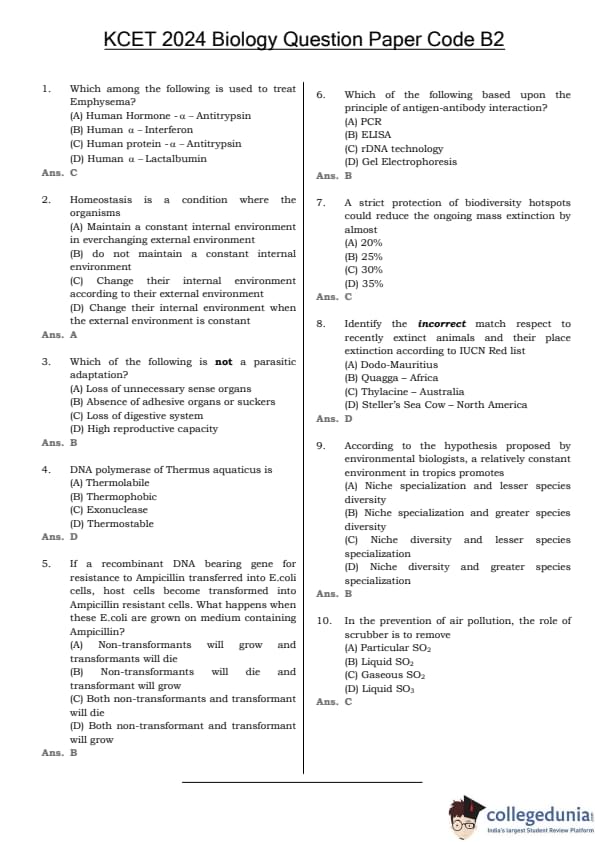
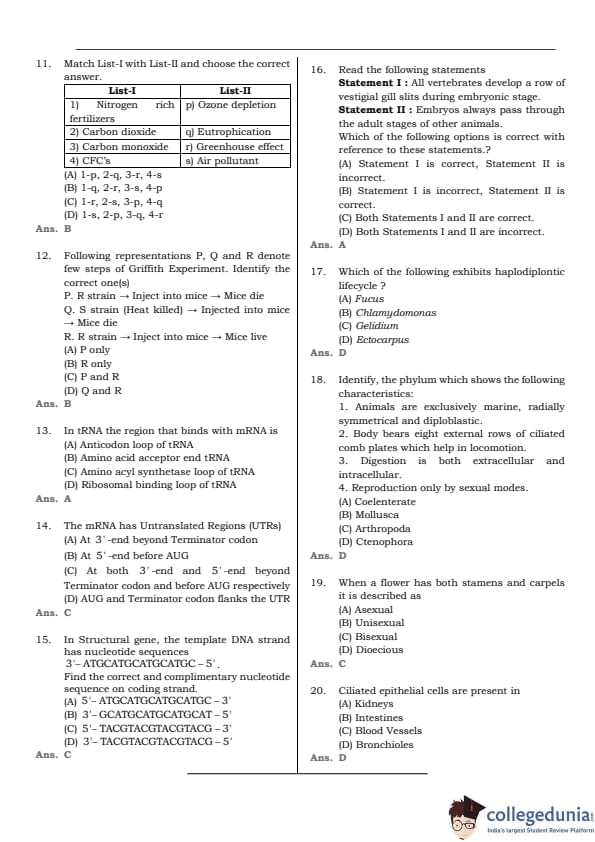
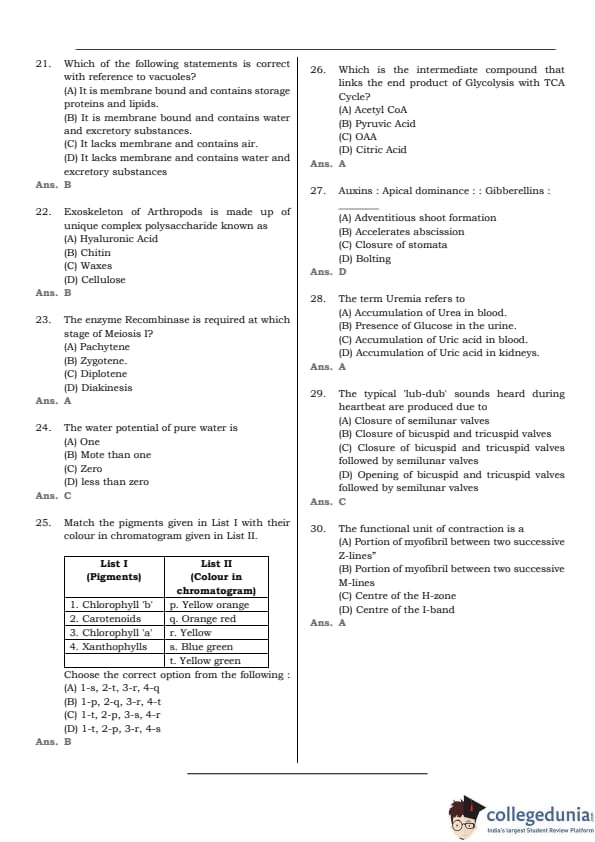
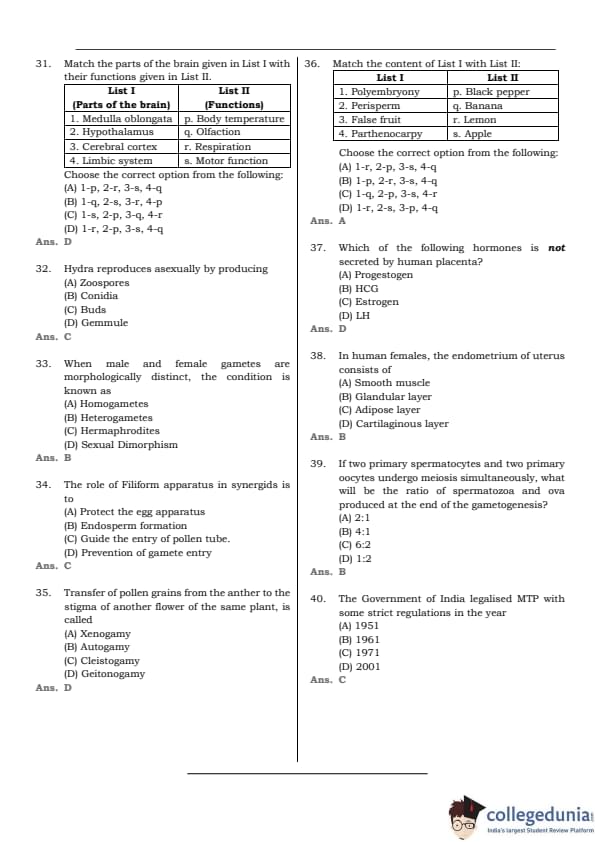
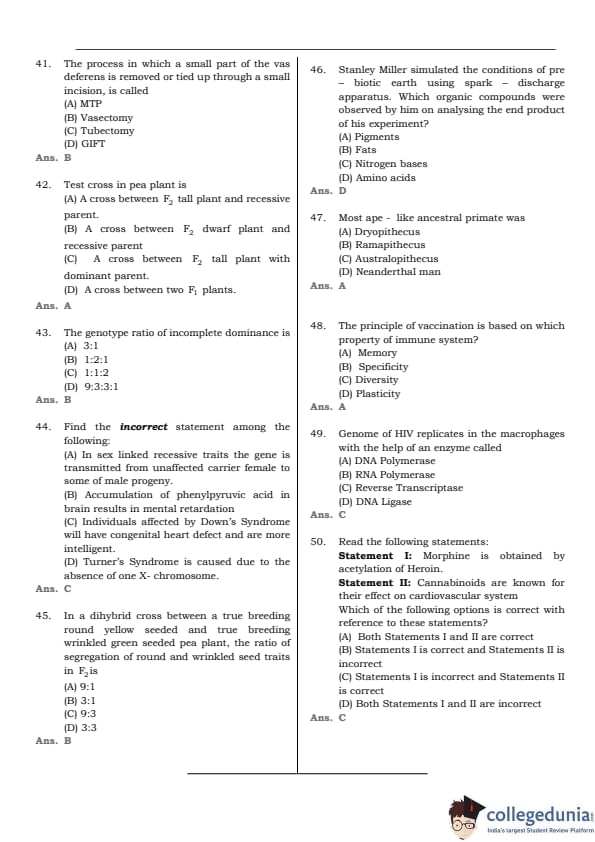
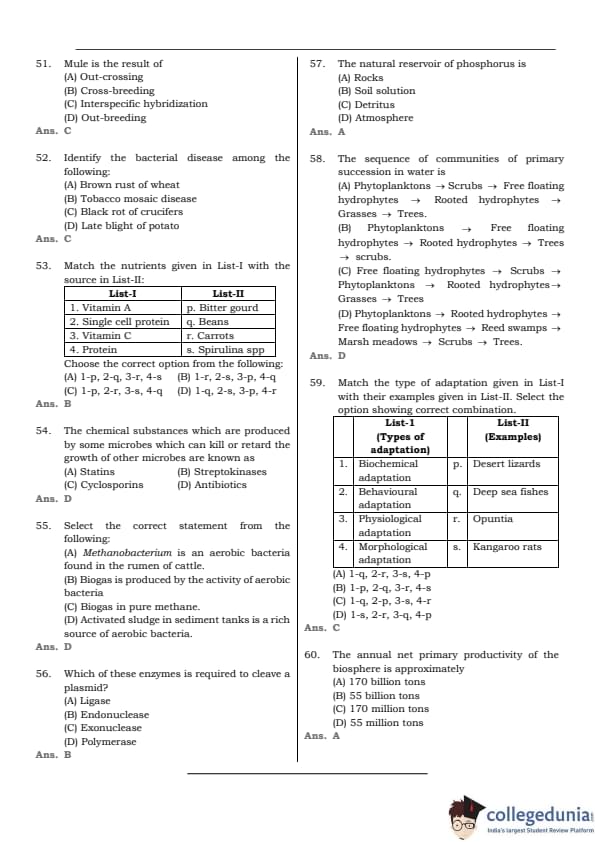
Also Check:
KCET Previous Year Question Papers
| KCET 2023 Question Paper | KCET 2022 Question Paper | KCET 2021 Question Paper |
| KCET 2020 Question Paper | KCET 2019 Question Paper | KCET 2018 Question Paper |




Comments